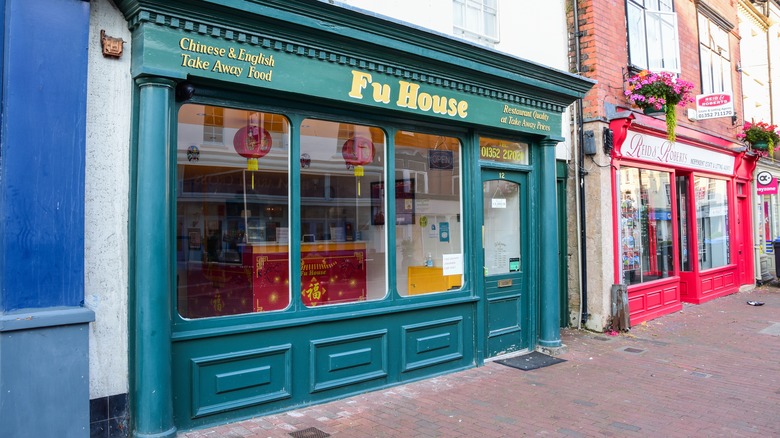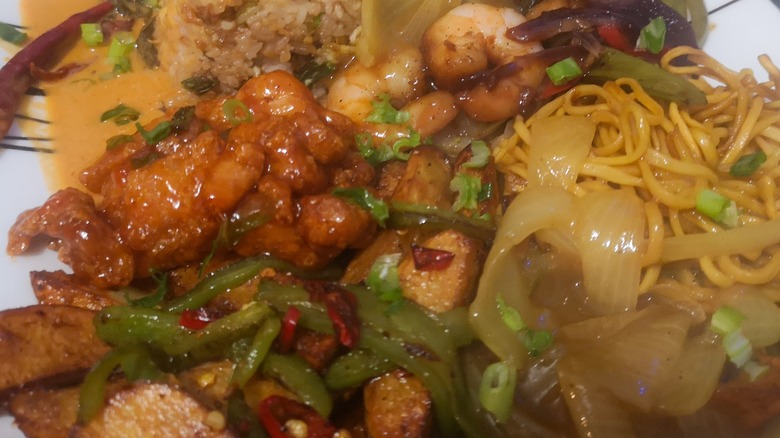What It Means When British People Order A 'Cheeky Chinese'
For well over a year, an international debate has raged over British people's attitudes towards takeout Chinese food. In a since-deleted 2023 post by Asian American TikToker @soogia1, she expressed disbelief at the Brits' unboxing videos of Chinese to-go meals, or "takeaway," as referred to outside of the US. Beyond seeing food included that is not authentically Chinese, such as fries — pardon, "chips" — and heaps of curry sauce, Soogia especially took offense at British people calling their takeaway boxes "a Chinese." Some diners even call it a "cheeky Chinese."
Is assigning the name of a race of people to a box of food unintentionally racist, as Soogia mused? Turns out, "a Chinese" is simply shorthand for the takeaway being ordered; a hungry Brit could also order "a curry" as Indian takeaway. Should one go to a "chippy" or "chip shop" for takeaway fish and chips, it's just as likely that they could pick up Chinese food there, too. In the UK, to call something "cheeky" implies that it's a little bit naughty, but still enjoyable. Put it all together, and going for a cheeky Chinese simply means that a British person would like to indulge in their country's not-exactly-healthy take on Chinese cuisine.
With the nomenclature sorted, Americans were still aghast at fries and heavy, deep-fried chicken balls sharing space with more conventional Chinese menu items in a takeaway order. Sometimes known as a salt and pepper box thanks to those seasoned chips, "a Chinese" reflects the ingenuity of immigrant restaurant owners in meeting the unique palates and scarce resources for Chinese food's origin in the UK.
How British Chinese food evolved to suit local tastes
British and Chinese dining cultures first crossed paths on colonial trading routes, as Chinese men hired on British ships eventually settled within England. Chinese restaurants exponentially spread as immigration laws adapted to accommodate more people entering the country post-WWII. As traditional fresh ingredients for Chinese food were scarcer in their adopted country, restauranteurs pivoted to using canned foods and whatever produce was easily available. The takeaway shops also included dishes meant to cater to British preferences, so it soon became common to find fried fish and Indian foods served alongside classic Chinese items. These restaurants became a source of community within local neighborhoods, with people from all backgrounds coming together over a plate of food. This community culture extends to the abundance of round tables at dine-in Chinese restaurants, creating equality as the Lazy Susan spins.
Americans' reaction to British Chinese food is interesting, considering how the food is served in this country. Panda Express orange chicken isn't exactly authentic Chinese cuisine, after all; dishes many in the US would consider "classic" Chinese, such as chop suey and General Tso's chicken, were created or adapted stateside. Much like their UK counterparts, Chinese immigrants who opened restaurants in the US made do with local ingredients and altered recipes to match American palates. Over time, discriminatory attitudes about spicy "exotic" foods and the prevalence of MSG in Chinese food are shifting, but Americanized recipes remain prominent. In fact, 2015 GrubHub data revealed that General Tso's chicken is the most popular Chinese food item ordered via the service in the US.

